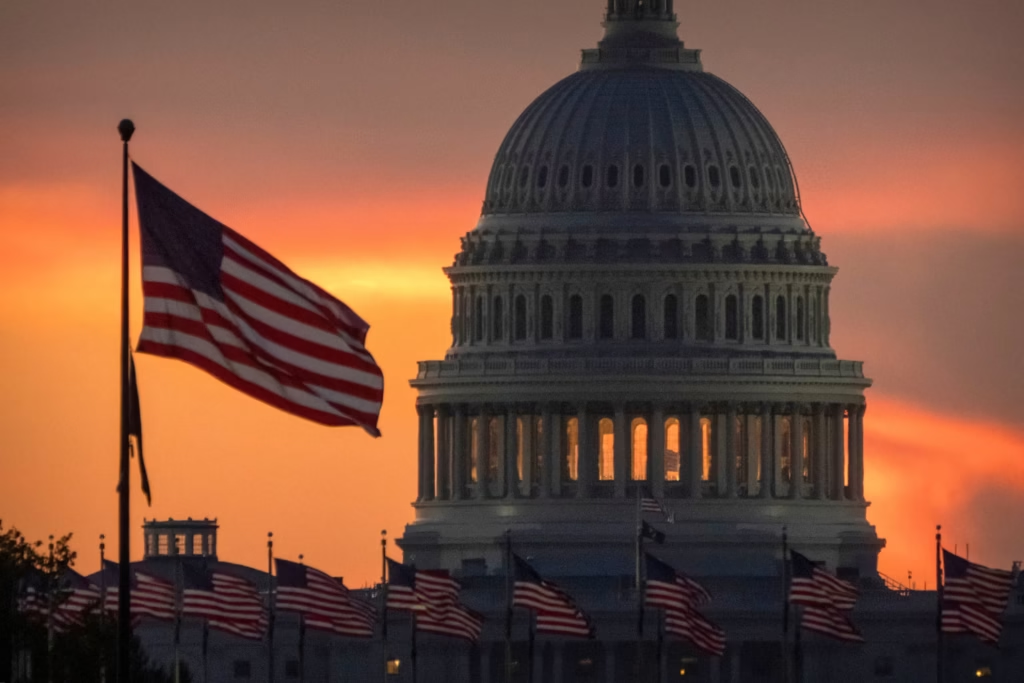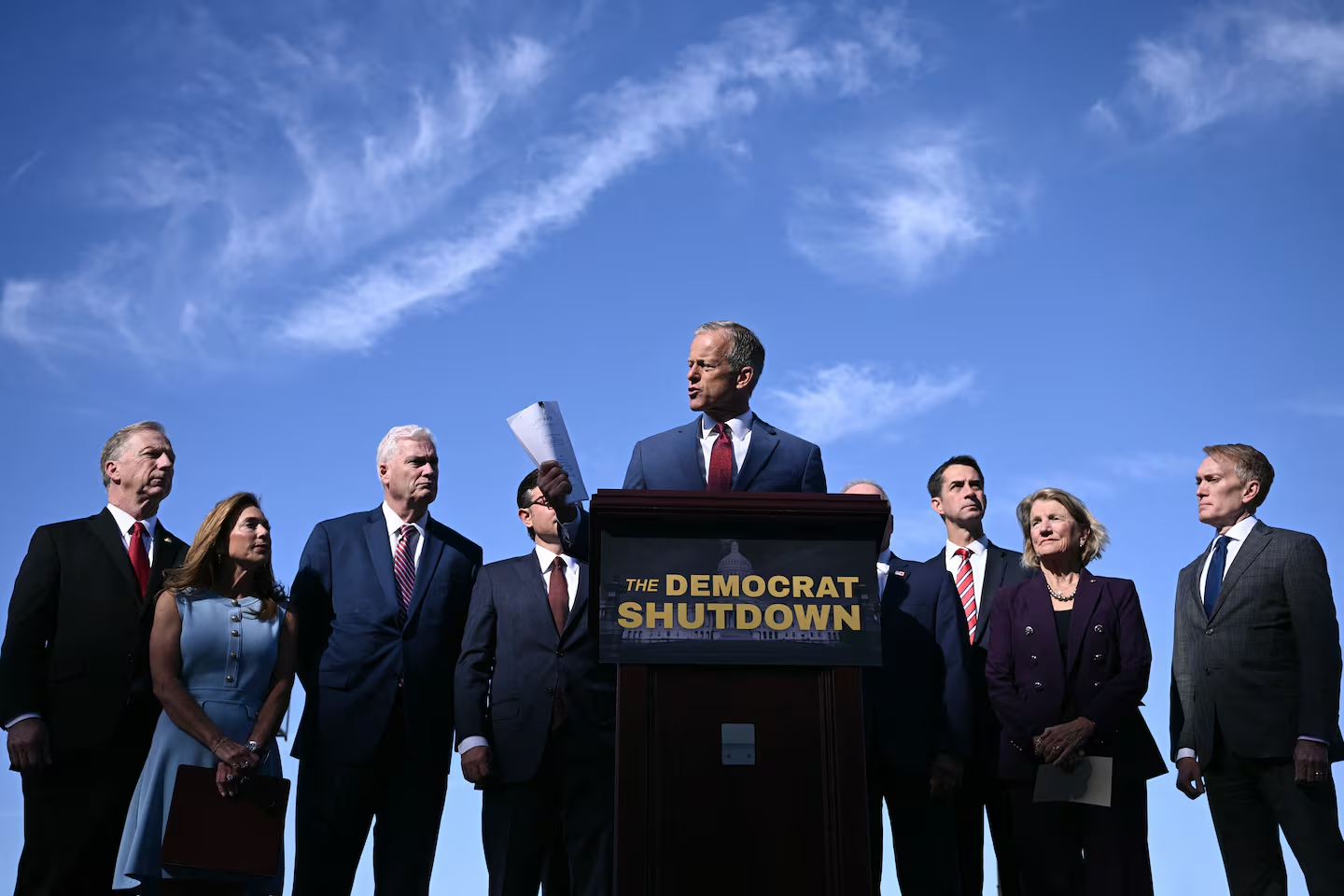The U.S. government shutdown began at midnight on October 1, 2025, following a failure by President Donald Trump and Congressional Democrats to reach an agreement on government funding. The shutdown is expected to furlough approximately 750,000 federal employees, including workers in national parks and financial regulation, who will be put on leave without pay until the funding issue is resolved. Essential employees, like military and law enforcement, will continue working but will not be paid during the shutdown.
President Trump has threatened mass layoffs of federal workers during the shutdown, warning that “vast numbers” of federal employees could face termination, particularly those whose roles do not align with his administration’s priorities. The White House Office of Management and Budget advised agencies to prepare for significant job cuts if the shutdown continues, and two federal employee unions filed a lawsuit in response to these threats.
The shutdown stems from disputes over health-care policy funding, with Democrats demanding extensions of health subsidy tax credits and Medicaid reversals, which Trump and Republicans oppose. Both parties have blamed each other for the shutdown, with the White House blaming Democrats and the Democratic National Committee blaming Republicans. The Senate failed to pass temporary funding bills needed to avoid the shutdown, with votes falling short of the required threshold.
The Congressional Budget Office estimates the shutdown will withhold around $400 million in daily wages from furloughed workers. While furloughed employees are expected to receive back pay once the government reopens, some layoffs may be permanent if the shutdown persists. The duration and full impact of the shutdown remain uncertain, with ongoing political standoff between President Trump and Congress.
Which federal services are affected first by the shutdown
The federal services affected first by the government shutdown include closures and furloughs impacting about 750,000 federal employees. Many federal offices and agencies suspend operations unless related to essential services or mandatory funding.
Key affected services and impacted agencies at the shutdown start include:
- Social Security Administration: Continues to provide disability and retirement benefits but furloughs 12% of its workforce and halts marketing efforts.
- Medicare and Medicaid: Remain operational due to mandatory spending.
- Federal law enforcement agencies (FBI, CIA, DEA, Coast Guard): Continue operating with employees working without pay.
- U.S. Postal Service: Continues normal operations since it is not funded by tax appropriations.
- Internal Revenue Service (IRS): Operates for an initial period but faces uncertainty beyond that; has already seen staffing cuts before the shutdown.
- Air Traffic Controllers and TSA: Continue working but will not be paid during the shutdown.
- Federal courts: May exhaust funding rapidly, facing potential closures within days.
- National Parks: Open for public access to roads, trails, and outdoor memorials, but buildings and facilities are closed and services limited.
- Department of Veterans Affairs: 96% of personnel working, but regional offices and certain services like headstone installations are halted.
- Critical cybersecurity operations within DHS face furloughs, potentially hindering response capabilities.
- Many federal agencies unrelated to public safety or property protection (Education, Commerce, Labor, State Department) experience large furloughs, halting most operations.
Most veterans, active military personnel, and National Guard forces continue working without pay. Disruptions also affect communication lines, hotlines, and certain benefits services.
This is based on the first impacts observed as the 2025 shutdown began, with broader effects dependent on the shutdown duration.
How will Social Security and Medicare be affected

Social Security and Medicare benefits will largely continue unaffected by the government shutdown because they fall under “mandatory spending,” meaning their payments have been pre-approved by Congress without expiration. Social Security beneficiaries will keep receiving monthly payments without interruption, and Medicare coverage will remain in place. However, some administrative and customer service functions may be disrupted or delayed, including benefit verifications, earnings record corrections, updates unrelated to benefit adjudication, overpayment processing, and replacement of Medicare cards. New applications for both programs might face delays due to limited staffing without pay. Additionally, the announcement of the Social Security cost-of-living adjustment (COLA) for 2026, usually released in October, could be postponed because the calculation depends on data from the Bureau of Labor Statistics, which may cease operations during the shutdown. Essential Social Security staff will continue working without pay during the shutdown to ensure benefit payments are maintained.
What to do if my Medicare card needs replacement during shutdown
During the government shutdown, if a Medicare card needs replacement, individuals can still request a new card, but there may be delays due to reduced staffing. Replacement cards can be requested online through the personal “mySocialSecurity” or Medicare account, by phone, or by visiting a local Social Security office. The card will typically be mailed within about 30 days to the address on file. For immediate use, a digital copy of the Medicare card is available through the Express Plus Medicare mobile app or online Medicare account, which can be used until the physical card arrives. Medicare customer service phone lines are also available for assistance during the shutdown. It is recommended to create or maintain an online account to manage such requests conveniently during this period.
Government shuts down after Trump and Congress fail to reach deal
The U.S. government officially shut down at midnight on October 1, 2025, after President Donald Trump and Congressional Democrats failed to reach an agreement on a temporary funding bill to keep the government operating. The shutdown marks the first federal funding lapse since 2019. Key disagreements centered on Democrats demanding extensions of health care subsidies and reversals of Medicaid cuts, which Republicans and the President rejected. The Senate failed to pass competing funding proposals from both parties, with the Republican bill falling short of the 60 votes needed. Trump has threatened mass layoffs during the shutdown and accused Democrats of forcing the shutdown, while Democrats blame Republicans and the White House. About 750,000 federal employees face furloughs, with an estimated $400 million in daily wages withheld. Essential workers, such as military and law enforcement, continue working without pay. The shutdown will halt many government services and disrupt various programs, and the House is in recess to exert pressure on Democrats while the Senate continues voting on funding measures.
Which federal services remain available during the shutdown
During the government shutdown, several essential federal services remain available while many others are temporarily suspended:
Services that continue:
- Social Security payments, Medicare and Medicaid benefits will continue as they are funded by mandatory spending.
- Military personnel, including 2 million active-duty and National Guard forces on deployment, continue working without pay.
- Federal law enforcement agencies such as the FBI and CIA maintain operations, but employees work unpaid.
- Air traffic controllers and most Transportation Security Administration (TSA) staff continue their duties.
- U.S. Postal Service operations carry on, with post offices remaining open due to their self-funded model.
- Some veteran services continue, with 97% of Veterans Affairs staff on duty though regional offices may close.
- Disease outbreak monitoring by the CDC continues at a reduced capacity.
- Nutritional assistance programs like SNAP and WIC remain operational, thanks to contingency funds.
- National parks remain partially accessible with limited services, but visitor centers and staffed buildings close.
- Smithsonian museums and the National Zoo use prior funds to remain open temporarily.
Services that are suspended or limited:
- Many federal employees are furloughed and remain unpaid until the shutdown ends.
- Federal grant programs including those for early childhood education (Head Start) are paused.
- Student financial aid processing, including Pell Grants and federal student loans, faces disruptions.
- Federal courts warn of potential closures soon due to funding exhaustion.
- Replacement issuing of Medicare cards is delayed.
- Tours of major government sites such as the Capitol, White House, and Supreme Court are canceled.
- Processing of federal gun permits halts.
- Some veteran benefits like installation of permanent headstones and cemetery maintenance stop.
The shutdown impacts many government functions, but mandatory spending programs and critical safety and security operations remain active, often with staff working without pay until funding resumes.
HOW A FEDERAL GOVERNMENT SHUTDOWN WOULD AFFECT YOU

A federal government shutdown affects many daily life aspects, with a mix of services continuing and others halting:
Services continued during the shutdown:
- Social Security and Medicare benefits continue as they are funded by mandatory spending.
- Military personnel, including active duty and deployed National Guard, work without pay.
- Federal law enforcement agencies such as FBI and CIA maintain operations, though employees may be unpaid.
- Air traffic controllers and TSA workers stay on duty but without pay.
- U.S. Postal Service continues normal operations as it is self-funded.
- Most veteran services continue, though some regional offices close and certain cemetery maintenance stops.
- Nutritional assistance programs like SNAP and WIC continue.
- National parks remain partially accessible but visitor centers close.
- Smithsonian museums and the National Zoo stay open temporarily using available funds.
Services paused or reduced:
- 40% of federal workforce, about 750,000 people, face furlough without pay.
- Passport processing is delayed.
- Federal grant programs, educational assistance, and federal court operations may be halted or delayed.
- Federal employees processing Social Security checks or Medicare cards may be furloughed, delaying some administrative tasks.
- Some veteran benefits like installation of permanent headstones and cemetery grounds maintenance stop.
- Government tours, including the Capitol, White House, and Supreme Court, are canceled.
- Delays and limitations in federal contract awards and acquisitions.
Federal employees categorized as non-essential are furloughed and unpaid, while essential workers continue without pay but traditionally receive retroactive pay once the government reopens. Travel delays may occur due to air traffic controllers calling in sick as seen in past shutdowns. The shutdown will negatively affect government research, public services, and scheduling, with potential ongoing impact on government workers’ finances and public access to some government functions until funding is restored.
This overview helps prepare individuals on what to expect and how critical services may be impacted during the ongoing federal government shutdown.
How to check if my federal agency is affected by the shutdown
To check if a specific federal agency is affected by the government shutdown, individuals can:
- Visit official agency websites, which often post shutdown updates and operational status.
- Look for official communications or press releases from the agency, as many provide guidance on which services are operational and which are paused.
- Use resources provided by elected representatives’ offices or government websites that aggregate shutdown impact information across federal departments.
- Contact agency customer service or help desks, though wait times may be increased due to reduced staffing.
- Monitor announcements on the Office of Personnel Management (OPM) website, which provides guidance on agency operations and employee furlough status during shutdowns.
- Follow news updates from reliable sources covering government affairs as they compile shutdown impacts and agency statuses.
In general, agencies performing “essential” functions related to national security, public safety, or mandatory programs remain operational, while many others face furloughs and temporary closures. Agencies involved in passport processing, justice system functions, immigration hearings, and some public health and research programs may experience significant service disruptions or shutdowns.
For a more comprehensive and updated list, some Congress members or governmental websites maintain a live resource page specifying which agencies remain open or closed during the shutdown. These sources can be helpful for the latest, agency-specific shutdown impact guidance.
Learn how to request emergency advance pay during a shutdown
To request emergency advance pay during a government shutdown, federal employees should:
- Contact their immediate manager or supervisor to discuss eligibility and process for requesting an emergency salary advance.
- Managers are responsible for determining eligibility and obtaining necessary approvals per departmental procedures.
- Employees typically complete a request form for the emergency salary advance.
- The request must be authenticated and submitted through the proper channels, often involving finance and payroll departments.
- Emergency advance payments are usually based on a percentage of the employee’s gross pay entitlement and are not considered traditional advances but payments for work already performed.
- Employees do not have to accept the advance if offered.
- Agencies have specific internal processes to handle these requests, and employees should follow their agency’s instructions.
Since agencies handle emergency advances individually, employees should start by contacting their supervisors or human resources office to understand the exact process and required forms. Documentation and approvals are critical to processing these payments quickly during a shutdown.
This approach is aligned with federal practices for managing pay issues during lapses in appropriations, ensuring employees can access needed funds in emergencies.

